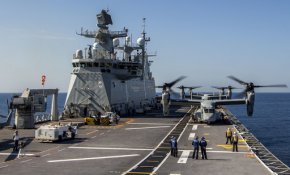Nice summation and questions on the F35B subject.Some sceptics suggest that an ADF CVL and F-35B option is pie in the sky, which is fair enough based upon the evidence of the latest ADF equivalent of a Defence Capability Plan. I don't think that using a LHD as a temporary CV is going to cut the mustard either. One of my reasons is that whilst multi-roling can be good, it also can be taken to far and you end with a frankenform that's of no bloody use for anything. The other is the oft repeated reason of reduction of the LHD's core reason for existence - AMPHIB OPS. If the RAN was the size of the USN, that wouldn't be such a major factor.
However we don't know what the future may bring and it could be that CDF decides that the situation warrants either a change in ADF CONOPS and capabilities or it doesn't. That's what it comes down to. All going well, they will make that decision based upon the best possible information available to them. If a change is deemed necessary, then it is presented to the pollies for their approval. We all know that's how it works.
I think now rather than focusing upon which platforms / capabilities are best, we should actually determine whether or not such a capability is desirable within tthe ADF and if so the logical reasons why or why not. To my way of thinking, just because other countries such as Spain, Turkey or Italy have such capabilities is not a valid reason for Australia to have the same.
Why do those three countries want to operate fast jets off decks? We could undoubtedly find many military reasons, but what is the overarching main justication for pouring billions out of a national treasury into such capabilities for a midrate navy of a country that doesn't really have the treasure to splurge on such expensive projects? Yes I know Turkey has been expelled from the F-35 program. Is it because of prestige - a my dick is bigger than your dick type of competition - that these three nations have gone down this path? After all the Spanish and Italians are well known for it and have a long history of such behaviour going back to Roman times. WRT Turkey we all know the size of Erdoğan's ego so it's nothing unexpected of him. Now that he can't get his F-35B, he might have to ask his cobber Vladimir for some Yakolev VTOL aircraft. But whatever the reasons, all three economies aren't the best performing in the world and such expenditure may have been better spent elsewhere in their defence budgets.
Then we have South Korea and Japan. Unlike the three nations mentioned above they are in a region where an aggressive nation, PRC, is pursuing an active expansionist program utilising grey warfare methods to illegally sieze maritime assets and territory. The PRC is building and expanding a navy that now exceeds the USN in size. The physical closeness of South Korea and Japan to both the PRC and NK makes their landbased airpower vulnerable to both PRC and NK missile attack.
Australia is not in the position of South Korea or Japan, and whilst us Kiwis like to think that Aussies are sometimes up themselves,we generally don't think that they're that far up themselves to have a project such as this for purely vanity reasons. So putting platforms to one side for the moment:
I think that these are the questions that have to be answered before any debate upon platforms, numbers etc., can be had.
- Is such a capability required by the ADF?
- If so why? And,
- Conversely if not why not?
- What are the actual advantages and disadvantages for Australia to have such a capability?
- Since such a capability is not seen by the government as necessary at the moment, is it foreseeable that this position will change?
- If so, why?
- If so, when?
Obviously I fall in the yes camp.
I have already given some but not all the reasons for my opinion.
What I feel is important however is to have the conversation.
The subject is too important to be dismissed as some fan boy fantasy fleets stuff.
Yes it is a major undertaking in capital and training.
Yes it MAY / MAY NOT compromise what can be accommodated aboard the LHD's.
It is however always about what it adds to the ADF, not what it takes.
That is the conversation.
Cheers
Regards S

